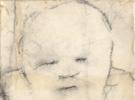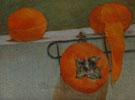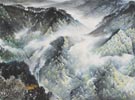Self-turning: the Critical Images of Ego and Alter
On paintings of LI RUIHUA
By ZHAO Song
Jun. 12, 2011
If we can propose that the daily vision throw too much customary illusions, then obviously it thanks to the often “look but not seen” way of seeing. There’s never enough example for this. In reality, people look, but when he’s required to describe, mostly he can’t even say a word, or just simply give description with a combination of pronouns, nouns and verbs. The population of camera and VCR thanks to the instinct of recording things, which enables them to be able to prove what they saw. While what’s paradox is the still or fluxus daily images are often the proves of their “look but not seen”. What you’ll discover is the likewise disappearance of the ego as the one who look/subject of photography and alter as the one be seen/object of photography when the image is born. What’s left behind is a site with absent subject and object. The “look” they hold are on the sense of group instead of individual, or even more precisely, programed instead of personalized. After all, most of the time they cannot lightheartedly SEE anything, but look at what everyone can.
Start from this point, the fundamental difference between real artists and ordinary people is not about their artistic crafts, but their way of seeing, of discovery, they can see the “reality” which can not be seen by the mess. What’s more, they transform this “reality” into an artistic existence in their own way. They can always reflect the momentariness and richness of reality by creating a unique vision. They question about the way of seeing, the reality of the existence of ego and alter, and the variety of phenomenon born from the complex relationship between ego and alter in the nearly ultimate real world. So the real artists are the ones who stay nearest with the world, the ones who experience the deepest and can describe well about his situation. They always try very hard to get a deeper observation about the world, to get a clearer knowledge about the existence and limitation of ego, and then carefully hide the ego down the bottom of their works. So when the viewers face the works, what they see is always a vision that never ever existed in the reality, which enables them to taste the mysteries inside the works by carrying an experienced viewpoint. Only when people can face those works with a specific subject, and realize the subjective existence status of the alter, the works will over shade their truth, to become the field where the visions of ego and alter meet.
As a young artist, LI is just starting. In a certain extent, her art creation is just around the critical state, it’s tightly related to her value in development. From her works in the past two years, she’s not really position herself as a “side watcher” during the process of observing and experiencing the reality, but a more hidden angle from where her ego can become transparent merge into the projection shade of the variety of daily objects, which is more safe and proper for her. She prefers to project her opinions and imaginations from the back of objects, which obviously told by her series of oil on canvas SHOT. Maybe the first impression of these works will bring you a nature connection with photograph negatives, even kind-of style by Marilyn Duma,then unconsciously you would low down your expectation for the work and doubt the originality of it. But in fact, if you raise your patience to come closer, give a bit more time, then some delicate qualities of the creation would float up. Actually at the moment when LI entitled the series SHOT it reviews some potential of the works. Like many contemporary artists, she chooses images as materials to escape the tradition of representation. But these images used as materials were not photos “shot” by her, but filtered from thousands of portraits “shot” by others, in this point, her filter is actually a secondary “shot”, because image Itself is a reality, an existence in the daily reality, like millions floating in the rivers. And when she position them in her photograph negative vision, it actually becomes a third “shot”, these three shots are only a beginning of her creation, not creation itself. While during this process, multi impressions have been achieved in her mind, images turning, the original object of the imagines, some hidden background will merge up and ferment, finally turn into a projection in her mind which composed of some transient images in the alter world, and contribute a delicate relationship with her mind. In another word, the process of their transform into image becomes also some kind-of boundary in-between her as the subject of seeing and the alter world. She doesn’t seems to care where they come from, what they are, what she cares about is what kind of fresh image can be generated from them onto the canvas, become a imaginary bridge links ego and alter.
For instance, in the SHOT No.3 which is comparatively representative, what we see is a female figure in the dark, her face and neck sound like bronze sculpture, a hat decorated with hair like patterns, grey-white lined dress breath out a lightness as feather through a imaginable minor light comes from inside. The contrasts between light and dark, light and heavy contribute here an effect that time could instantly disappear. What LI trying to capture here is not any more a still image, but a will to escape completely from the image of existence itself from the influence of time. The figure of the young female stranger in the image is no more a transient captured by alter, but a life suddenly floating and engraved in the painter’s dream. She doesn’t know who “she” is, but she knows that “she” is just there, holding an indelible existence. Subconsciously, LI consider the daily reality as a kind of dark background; only the ones who carry light in heart will catch the possibility to discover each other. Without this light, we can no longer find the Déjà Vu alter. What’s even more interesting, the hair, dress of the figure carries a deco beauty of “object”, like the bird feather. Especially the detailed patterns over the dress, suggest a fluxus feeling echoes the still be lightened image. In this representation, LI shows her high sensitivity towards objects and form as a young woman.
This portrait themed series SHOT mostly presents female, and among which mostly are models. While it must not be difficult for us to discover the figure of all these models are not that shiny thing over the stage, but all carries a mysterious color. What LI wants to discuss here is not a simple upside-down of a common impression of the models, but trying to approach the information hide behind the complex relationships in between a show-sense daily individual and fantasia. So what’s more thought provoking are the images with other female figures instead of the models. Take example of SHOT No.2, No.4 and No.33, among which, No.2 is the only one in this whole series which carries an obvious tendency of humor. Back grounded with a grey-white, a happily laughing woman catches my eyes with her branch-like black arms; those giant leaves seem to grow out of her “body” instead of simple decoration. So in this image, the objectivity of human got released and brings the viewers from complexity to naïve, like the trees breeze in the spring wind, decorates a certain moment in reality. In No.4, a dressed female painted with black again, the dark gets shallow while the camera moves down, her face was blurred as being corrupted from the original look, both of her arms strangely stretched as received an accidental hurt, so as the horror along. Then in No.33, a savage female face is exactly what we see, it seems like she look into the mirror at her face, time flying and suddenly she is old, she feels so anxious about the fragility, … maybe even she doesn’t know what exactly happened, not in front of the mirror, but only towards somebody or some scene, without self-sense. Through these works, we’ll know the orientation of LI is more focused on the female face that carries some specific meanings. Accordingly, the hair, dress and decorations echo against black or white background, the faces are exactly floating over them.
LI try to express her own knowledge about the conflicts between the individuality of female and her situation through these images. In reality, sometimes it’s difficult for females to stand independent, they have to face and defend themselves from chaos. They never stop to make them seem more energetic, young and beautiful, decorate themselves to be somehow different. While suddenly one day, they would wake up and question themselves: Are all these useless? Am I helping myself to escape from the chaos? So actually what LI discuss about this the independence of female in the society, she takes this as a starting point on which she’ll construct her thought and creation. To some extent, only the ones who are individualized on a real extent can them own an independent life as the planets turning on their own tracks. They constantly interact with the world through a variety of aspects and produce fantastic phenomenon and imagery. LI’s painting as a trial, expresses a insight of those extraordinary transient female images through turning the vision, but through a multi-structure of transforming images to mirror the constant pursuit towards the blurred area in reality of an individual woman. For LI, it’s like a window, what she needs to do is not only move near the window and see through the world outside, neither locate her own way of seeing and discovery, but make the window disappear and walk into that always been distant outside world, as a stranger in a stranger place to start over an absolute new journey. “Throw yourself into the unknown”, said Heidegger.




